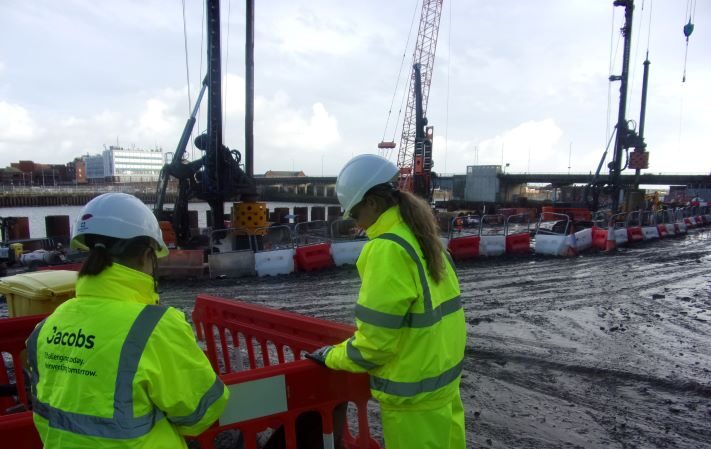In the first of two articles around apprenticeships, SHP’s Rhianna Sexton speaks to Jacobs’ HSE apprentice Elizabeth Clingan, and her mentor Donnie Bellshaw, Head of HSE Defence and Security, about their careers and advice for others looking to join the industry.
Discussions continue around how to make health and safety an attractive career for young people. As well as shining a spotlight on how satisfying the role can be, it is also plugging the ‘skills gap’, as the chasm left by retiring HS professionals is failing to be filled by a new cohort of young apprentices.
However, established health and safety professionals mentoring apprentices could solve both issues. Jacobs, a global engineering and construction company, has its own established trainee and development programme – previously we spoke to HSE Director, Eddie McGrath about this process and his own career.
Here, Elizabeth and Donnie focus on what skills can be gained from an apprenticeship and how health and safety incorporates a whole range of exciting challenges.
SHP: Hi Elizabeth, what made you want to choose an apprenticeship in HSE?
Elizabeth Clingan (EC): I chose the apprenticeship route because I think it’s an effective way into work for young people like me who don’t feel that university is for them.
I continue to learn, gain practical experience, while earning a wage. I wanted to continue to educate myself and develop personally and I felt an apprenticeship was the perfect route for me.
I think it needs to be put out there more because for someone like me who didn’t know what I wanted to do after school, it was quite hard for me to find apprenticeships or jobs, so I think it should be highlighted more for those who are struggling to find a career path that interests them.
SHP: Could you describe the structure of the apprenticeship? What’s your day-to-day like?
 EC: The structure of the apprenticeship is full-time work experience with one day for college.
EC: The structure of the apprenticeship is full-time work experience with one day for college.
My days are varied. I could be reviewing any workplace activity to identify potential sources of risk, which could include how equipment is used, how duties are performed, identifying correct signage or use of PPE equipment.
I also look to identify any aspect of a person’s duties and the way they perform them that might cause harm to that person or those around them, and deliver Toolbox Talks on-site.
I really like to help people, and am a mental health ambassador at Jacobs, creating articles for internal publications too.
SHP: What has been your greatest achievement within the apprenticeship so far?
EC: My greatest achievement was taking my NEBOSH General Certificate exam early in my career. It was challenging, but working hard revising and talking to the team has helped broaden my knowledge.
My proudest moment was also delivering my first Toolbox Talk in front of over 70 people on a project! When I started, I was quite shy, so while on-site I’ve come out of my shell, and because I was scared of public speaking, I’ve pushed myself into doing Toolbox Talks to get out of my comfort zone and have grown in confidence.
SHP: Amazing to push yourself there, and have you learnt anything outside of HSE which you didn’t expect?
EC: Without a doubt I’ve gained in confidence; sometimes I take health and safety home and tell my parents: ‘you need to do that safer’ – the tables have turned!
Overall, I believe I’m a better communicator, and learned team working skills. Working with your team every day to complete the task at hand is very enjoyable and improved my language and written skills. I have also learnt to become self-reliant.
SHP: Would you like to continue in HSE after your apprenticeship?
EC: Most definitely. I feel a career in health and safety will be rewarding both professionally and personally. Helping others, promoting, and protecting is very fulfilling. I would also be privileged to stay with Jacobs – they are supportive, and I feel like I’ve been taken under their wing to grow.
My lead team and managers have been so helpful in guiding and supporting me and there are so many business sectors and opportunities to learn within the organisation – possibly even the chance to travel.
SHP: What advice would you give to someone considering an apprenticeship in HSE?
EC: I chose health and safety as I was always told I had good organisational skills, I’m also quite serious, and I knew I would like to work in a process-driven environment.
If you are considering an apprenticeship in HSE you will need to be organised, reliable, be prepared to learn HSE rules and regulations – as there’s quite a lot – and solve problems.
You also need confidence as there are times you will have to call something out if you think it’s wrong. You should have a desire to want to make things better, spot hazards, near misses and you will need to complete audits and investigations, so good communication skills are essential.
All require you to use your own initiative, but also work together with your colleagues and team. It is hard work, and the risks are high, but it is rewarding in equal measure so I would 100% go for it!

SHP: Thanks Elizabeth! And Donnie, could you give us a brief overview of your role, what do you enjoy about it?
Donnie Bellshaw (DB): I am the Head of HSE for the Defence and Security Operating Unit covering the UK, Europe and the Middle East responsible for developing and implementing our HSE and Beyond Zero programme (Beyond Zero is Jacobs’ integrated culture of care programme which is at the centre of everything we do,) that supports the operating business and aligns with the overall company strategy.
I also provide HSE advice and guidance to over 700 employees, working closely with project teams and stakeholders on a range of construction activities from design and build, refurbishment, new builds etc.
For a health and safety professional, if you go through your day and you’ve not had any reports of accidents or incidents, it’s a good day. But it’s something that you’ve got to keep on top of everyday to get the safety message across.
So, I really do enjoy my job, in addition to the day-to-day HSE role am very lucky to be able to spend time supporting our social values programme with local charities within our communities. We do an awful lot of that and it’s so rewarding to organise a golf day or charity event to raise money.
SHP: Why are apprentices so valuable to health and safety?

Elizabeth and Donnie speaking to Rhianna
DB: Jacobs embraces people fully and therefore apprenticeships are an invaluable part of our Culture of Caring, in terms of safeguarding the business and its people for the future.
Part of their career journey is offering individuals the opportunity to gain important on-the-job training to learn the skills necessary to succeed in their desired field. Apprenticeships can be an ideal way to bridge the gap between education and the workplace providing valuable hands-on experience both practical and theoretical skills to guide the apprentice through their journey and I think that is especially important.
Other benefits of working with apprentices is that you can adapt their training according to the needs of the business and they’re motivated to learn new skills.
A lot of health and safety roles are filled by the older generation, and it’s so refreshing to see the younger generation choosing a career in something that keeps people safe, I think it’s terrific.
SHP: Where do you want to see the sector in 10 years’ time?
DB: Clearly, if we’re talking about the HSE sector then I would like to see an overall reduction in injures and ill-health within the UK.
HSE needs to be fully integrated as a business ethic in all organisations not just larger companies who have the resources for investment in people, infrastructure, and systems/technology. I understand and appreciate this will be challenging for smaller organisations, however they should endeavour to undertake this approach in a proportional manner.
Removing the risks to people carrying out high-risk activities, for example, Working at Height to conduct structural surveys, confined space surveys. During the pandemic, for example, when we couldn’t travel freely, we made good use of remote site walks with GoPro cameras and live Teams calls. Many of our project sites used drones to record progress and this proved to be very valuable.
Innovation can help us ensure a safe and secure work environment by quickly addressing any safety hazards and concerns that arise, taking corrective actions to ensure our people are safe and secure and provide must-know information in real-time, there is so much wearable technology available already and as time passes, these will be become more advanced and even more useful.
However, there must be a healthy balance between innovation and industry practices, as clearly not all activities can be undertaken remotely, there will still be a need to have people in the workplace, we just need to embrace technology to make it safer for all workers.
Further reading/listening:
The Safety Conversation Podcast: Listen now!
The Safety Conversation with SHP (previously the Safety and Health Podcast) aims to bring you the latest news, insights and legislation updates in the form of interviews, discussions and panel debates from leading figures within the profession.
Find us on Apple Podcasts, Spotify and Google Podcasts, subscribe and join the conversation today!

 EC: The structure of the apprenticeship is full-time work experience with one day for college.
EC: The structure of the apprenticeship is full-time work experience with one day for college.

